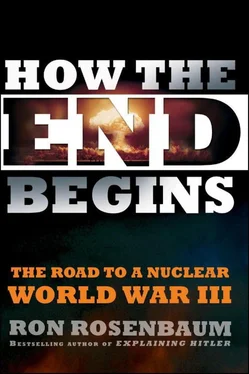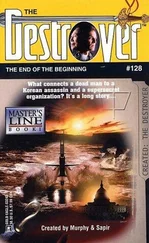What alarms Blair now is that this whole Cold War apparatus remains, for the most part, intact, except for parts of the Russian system that have deteriorated into uselessness. “We’re just kind of caught in this time warp,” he told me. The time warp: both superpowers, all dressed up and ready to go for so long, had no way to climb down from their Cold War ledges and brinks.
Eventually, Blair told me, resuming the narrative of his nuclear career, he found himself bored by the Looking Glass plane and RC-135 duties at SAC headquarters.
“So I wanted to hightail it out of Omaha as fast as I could and the only way to get out of Omaha at the time was to be accepted into some sort of critical job for which there was some acute personnel shortage because no one wanted the job. And there’s only like two of those jobs, one was a nuclear weapons control officer stationed north of Thule, Greenland, in some sort of Eskimo hut, and the other was to be a launch control officer for Minuteman or Titan missiles—which was a great assignment, as it turned out.”
He remembers every detail from forty years ago because it was a life-changing period.
“So they told me I could catch the next [missile crew] class if I was willing to pack up in twenty-four hours and get out to Vandenberg Air Force Base and start training the following Monday. So I threw some stuff in the car and I drove for like twenty-eight hours nonstop. I stopped in Salt Lake City to throw up from coffee and cigarettes. And I wound up doing a three-year stint in Montana at Malmstrom Air Force Base.
“And I wound up being assigned—because I was so on top of the war plan and all that—to the alternate wing command post, which is one of the underground centers that had the responsibility not for just ten primary and secondary missiles but for the whole base of two hundred missiles.”
“And when you say ‘responsibility,’” I asked him, “in case of crisis what exactly would you be doing?”
“Beyond launching—?”
“Would you be turning a key yourself?”
“Yes,” Blair said. “Turning a key. You interviewed these guys [the missileers]. You cited the spoon-and-string.” [165]
We spent some time discussing the shift in console alignment and design inside the launch control capsule that made the spoon-and-string ploy no longer possible.
But as I’ve suggested the spoon-and-string flaw in the two-key system can serve as a metaphor for the rickety architecture of the entire nuclear command and control system. And according to Blair, he discovered, in his capacity as wing commander, that the reality was worse. Because not only was the two-key system vulnerable, so was the “two launch votes” backup requirement, which requires two two-man launch crews to consent, “vote,” that a launch order is authenticated. One of the things Blair learned as a missile crewman was that he could have launched all two hundred of his missiles on his own.
“I had the duty of launching—participating in the mass launch of my wing of fifty Minuteman missiles,” Blair recalls. “And then additional responsibility for making sure that the rest of the wing—the other 150 missiles—got launched.”
And what would that entail, I asked.
“Making sure everyone received the launch orders and repeating the message if need be. You need two votes normally. But if the other votes don’t come and you’ve sent in your vote and the other votes don’t come [presumably] because they’ve been blown away, then one vote will launch the force after a short delay.” He could launch two hundred missiles with just one vote—his own—but that was not the half of it.
“As it turned out, later in my work I discovered there was widespread delegation of launch authority throughout the military chain of command. And there were some scenarios in which low-level officers could have created the launch command.”
How?
“Well people like me breaking into the safe [the glass-fronted box located above each console that contained the launch-enabling codes], getting out the codes, and putting those authorization codes into a launch order and then disseminating, communicating the launch order to my ‘friends.’ And that meant that people like me—our standing rule was if you receive a valid and authenticated launch command from any source you’re to carry it out… You’re supposed to fire without hesitation. That rule was long standing. It finally was changed when it was discovered that there were deficiencies in the system that would allow unauthorized people to do exactly what I said, which is to communicate launch orders that were not intended to be communicated that would be received and interpreted as valid and authenticated.”
In other words, not only could someone disseminate a nonauthorized order to launch a nuclear weapon, but the system itself had no way to make certain that the order came—ultimately—from the president. Alas, Blair insists—with a kind of desperate hopelessness—nothing has changed. Blair brought to my attention a draft of a letter he had written in 2008 to the Bulletin of the Atomic Scientists in response to an excerpt it had published of a book called A Nuclear Family Vacation, an account of a husband-and-wife reporters’ tour of nuclear sites. The excerpt detailed the then current silo command and control safeguards. [166]
Blair’s letter expresses not so much a wish to quarrel with the authors, as with the Pentagon PR people who were deliberately or inadvertantly passing along misinformation to journalists. It was a lifetime of frustration trying to get across a few basic facts about the flaws in the command and control system and the Pentagon’s misplaced confidence in it.
Letter to the Editor
I thoroughly enjoyed and admire the nostalgia-inducing article on nuclear missileers by [Nathan] Hodge and [Sharon] Weinberger….
It illuminates the core unresolved issue of their post–Cold War mission—what is the meaning of nuclear deterrence in the absence of enemies other than terrorist groups? It is generally accurate and quite insightful on many levels. The article fumbled some key details, however, some of which are important to get straight.
The assertion that missileers can only launch their missiles after receiving codes that come directly from the president is not correct. The codes in question are not held by the president, but rather by various command elements of the U.S. military. All of the codes used to authenticate launch orders and unlock missiles for firing are strictly held in military hands. They are widely dispersed among commanders to ensure that attacks on high-level command centers could not “decapitate” the authorization process. Such decapitation fears in the past led the Strategic Command to secretly circumvent the coding system mentioned in the article, unbeknownst to the Pentagon and White House.
Let’s pause here to digest this not well understood point: according to Blair, the president does not have the launch codes. He only has the Gold Code to identify himself and he has the targeting menu’s choice designations (plan g4: “take out all Russian leadership targets,” say). But he can’t personally translate this plan into launching a missile because the computer codes to feed into a missile’s GPS guidance system are in the hands of widely scattered military commanders. How many and who? Blair says he doesn’t know. But even if these codes need to be Gold Code–enabled, so to speak, it suggests the real possibility of workarounds by regional commanders that would allow them to effect launches on their own, especially in the event of a decapitating strike.
Blair’s letter continues:
The president possesses codes that are neither necessary nor sufficient to physically enable strategic missiles for launch. All this together with a long history of presidential pre-delegation of launch authority down the military chain of command raises some vexing questions about the true origin and lawfulness of a launch command. Although as the article intimates the issue rarely haunts the minds of firing crews, at least one courageous and conscientious missileer has ended his career by raising this issue.
Читать дальше











